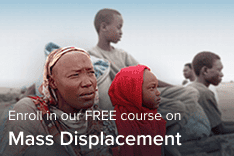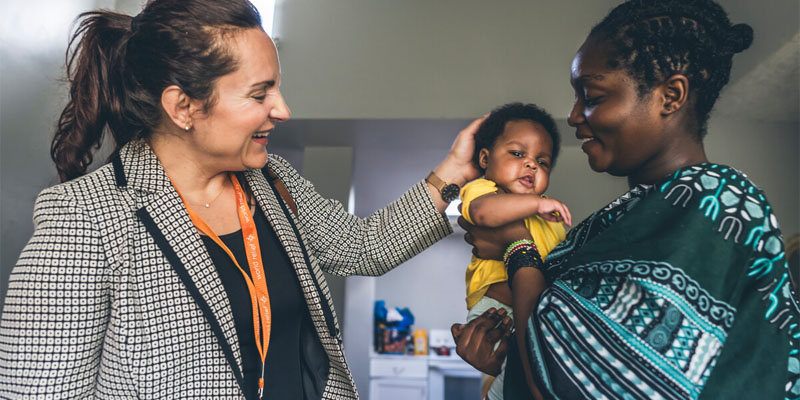5 Things to Consider About the U.S.-Mexico Border
The U.S.-Mexico border is a line extending more than 1,954 miles on a map. The region surrounding that line is full of life, families and possibilities. The richness in this region expands beyond what any of us can imagine when we consider its ecosystems and the nearly 20 million people that call it home.
In recent years, the U.S.-Mexico border has become a central point of conversations not only in political debates and the media but also in our communities, our churches and around our family tables. As followers of Jesus, we need to engage in conversations and spaces that lead to deeper understanding, empathy and widening perspectives.
In Luke 5:18-20, Jesus heals a paralyzed man — because some men responded to his need. Our response towards others is a public testimony of who we believe in and what we believe Jesus can do for others. Our compassion towards others reveals who lives in us.
Here are five key things to consider when thinking, praying and talking about the U.S.-Mexico border:
1. The Southern border region is binational.
An evident interconnectedness exists at the U.S.-Mexico border region. This is reflected geographically in communities like El Paso-Ciudad Juárez and in San Diego-Tijuana, as well as in the people who live there.
Many people who live along the border identify themselves as fronterizos or “borderlanders,” meaning they live life on both sides of the border. Thousands of people commute for a range of daily activities including work, school, church and leisure. According to the U.S. Department of Transportation, 653,450 pedestrians crossed the pedestrian border crossing in May 2024 at the San Ysidro Port of Entry. This means even everyday life involves crossing from side to side!
2. A humanitarian crisis is unfolding.
Recently, UNHCR released its 2024 Global Trends report, which estimates that the number of forcibly displaced people is likely to have exceeded 120 million by the end of April 2024. People across the world have been forced to flee their homes because of factors outside their control, which include persecution and conflict. These are not only refugees but also asylum-seekers and internally displaced people.
Global displacement plays an evident role in the realities that we are witnessing at the U.S.-Mexico border. What we see, and what I have witnessed since 2018 at the San Diego-Tijuana border, are vulnerable people, families and unaccompanied minors being pushed and pulled by factors that most times, are entirely outside of their control. The current and unprecedented reality in Southern California are open-air holding or detention sites, where those seeking asylum are held between border walls in San Diego for hours until processed by Border Patrol.
During these long holding times in extreme temperatures, there is limited access to water, food and medical care. Let’s imagine ourselves in that spot for a minute. It confirms the need for a more humane, compassionate and comprehensive response.
3. U.S. Immigration policies are complex.
Immigration conversations can feel polarizing and daunting, especially when laws are constantly changing. For example, in June 2024, President Biden issued an executive order that would impact those arriving at the U.S. southern border seeking asylum. Proposed bills and executive orders like this affect the lives and wait times of those arriving at the southern border — and for many of these men, women and children the ever-changing U.S. policies can feel just as overwhelming to them as they do to you.
This is why resources like World Relief’s immigration legal services are so important: they equip refugees and asylum-seekers with knowledge about their rights, regardless of status. In 2018, World Relief began supporting partner organizations’ efforts in Tijuana through Know Your Rights workshops. Knowledge is empowering and these workshops help those seeking asylum and waiting in Tijuana know what to expect when they interact with CBP (Customs and Border Patrol) at the port of entry, as well as what to do if they encounter ICE (Immigration and Customs Enforcement).
4. Compassionate hospitality is biblical.
As followers of Jesus, we believe that our faith informs and forms the ways in which we live our daily life. The concept of hospitality is woven throughout scripture from the Old to the New Testament. We witness the radical power of generous hospitality in Genesis 18:1-16 with Abraham and Sarah.
In the New Testament, Jesus lives and teaches compassionate hospitality through the parable in the Good Samaritan in Luke 10:25-37, and in Matthew 25:35-36, ”For I was hungry and you gave me something to eat, I was thirsty, and you gave me something to drink, I was a stranger and you invited me in, I needed clothes and you clothed me, I was sick and you looked after me, I was in prison and you came to visit me.”
Today, I see generous hospitality through the volunteers serving at our partner’s sites in San Diego-Tijuana that provide temporary shelter, warm meals and personal care items. Their availability, patience and learning posture exude a compassionate hospitality that says, “I see you, and I am with you.”
This can look like a ride to an appointment or an encouraging word. Compassionate hospitality doesn’t have to be elaborate; being intentionally present can also be an expression of hospitality, especially in the midst of uncertainty and change.
5. No migration journey is the same.
Each migration journey is as diverse as the individuals who embark on them. Migration journeys are shaped by personal circumstances, social contexts, motivations, geographical routes, available resources and push–and–pull factors like civil unrest, religious and political persecution .
Over the years, I have encountered people who journey for two weeks and others who have journeyed for three or more months. Some have traveled by foot, and others have traveled by car or train. Mexico’s most widely known train among migrants is La Bestia. All of these factors vary with each migrant and together influence the overall experience each individual, family and unaccompanied minor carries with them.
How can I support World Relief’s U.S.-Mexico-Border Work?
- Pray
- Pray for the migrants and asylum seekers on the journey seeking safety and welcome.
- Pray for the church to respond with hospitality and with faithfulness.
- Pray for political leaders to be compassionate as they propose and decide on laws and initiatives that affect real people.
- Pray for World Relief’s good work and that God will continue to provide guidance, creativity and wisdom.
- Give
- For 80 years, World Relief has supported those affected by crisis and displacement. Since 2018, we’ve been committed to identifying opportunities to address the humanitarian crisis unfolding at the U.S.-Mexico Border in church-centric, holistic and sustainable ways.
Currently, our Tijuana partners provide temporary shelter, warm meals and personal care items. In San Diego, our partners join these efforts through Good Neighbor Teams, advocacy and mobilizing local churches and communities to respond with gift-in-kind donations.
Learn more about this work and give today. Your gift will support these programs and expand our capacity to serve those seeking asylum at the U.S.-Mexico border.
- For 80 years, World Relief has supported those affected by crisis and displacement. Since 2018, we’ve been committed to identifying opportunities to address the humanitarian crisis unfolding at the U.S.-Mexico Border in church-centric, holistic and sustainable ways.
- Advocate
- Raise your voice to influence those in power.
- Contact your congressperson to advocate for due process for asylum seekers at the Southern border.
- Check out our other advocacy actions as well.

Liliana Reza is the Director of Border Engagement at World Relief, where she advocates alongside refugees, immigrants and displaced communities. An ordained elder in the Church of the Nazarene, she holds an M.A. in Intercultural Studies from Nazarene Theological Seminary. Based in the San Diego-Tijuana region, Liliana is passionate about building bridges through faith, justice and community — often found exploring the borderlands or training for her next marathon.


